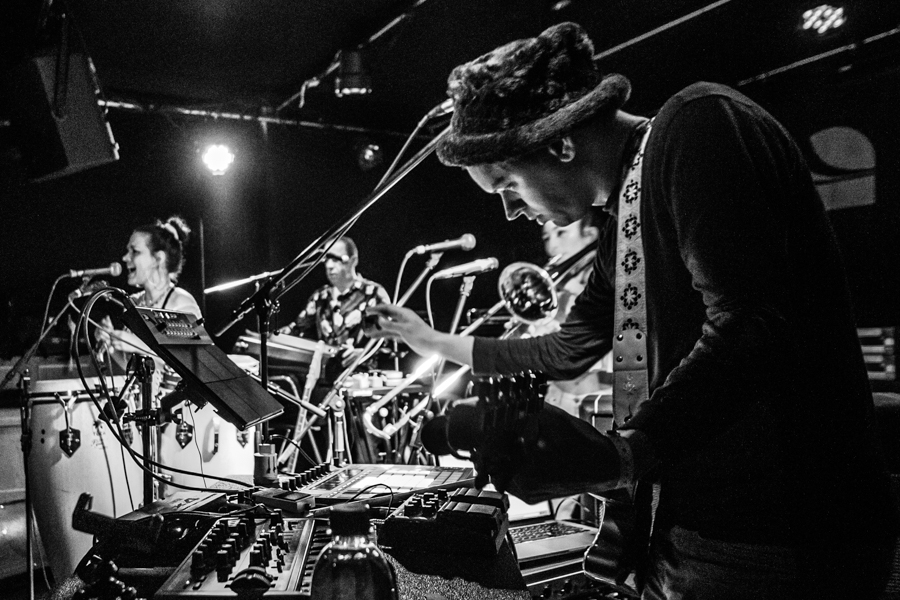By Mariafernanda Chavez

There is no denying the irrepressible attraction of British jazz music right now, with Brighton hosting an abundance of talented artists – Penya is one of them. We spoke to Percussionists Magnus Pl. and Jim Le Ms.
How long have you all known each other? How did you meet?
Magnus: The roots of Penya come from a 6-month long trip I took to Cuba in 2007.
On my return to London, I felt deeply inspired to create some of that amazing music in London – but I was a complete beginner, so I started looking for musicians active on the Latin scene and found Jim – since then we have been making music together.
Jim knew both Lilli and Viva from working in bands on the London Latin scene. Through these associations, the four of us eventually realised we wanted to create the same kind of music together. So, whilst this quartet line up has only been established for 18 months or so, we’ve actually been working on the ideas for almost a decade!
Which places inspire you to make music? What makes them special?
Magnus: The world of percussion is impossibly massive, and I’ve spent much time over the years travelling to different places investigating different percussion traditions by learning from local musicians – places like Istanbul, Kerala, Havana, Marrakesh, and Dar es Salaam all have different and strong identities – these kind of experiences have left an indelible imprint in my memory that I can associate with a particular sound, groove, or region. It’s really been a wonderful way to discover music, and Penya, for me, has been the meeting point of all these experiences.
Jim: We recently played a gig in the Alps, at the Worldwide FM Festival in Leysin. The sheer majesty of nature can’t not affect you in some way, and not only as an artist. We actually did some recording work while we were there for our collaboration with Dengue Dengue Dengue. Soon after that, we were in Rome, and on our day off we did some sightseeing. The sheer cultural density – two thousand years of it, heaped on top of itself, is pretty inspiring. We sat in a chapel on the Palatine Hill for a rest. It was empty, apart from the singing coming from behind a screen, which was impossibly beautiful.
Where has Penya performed and what’s been your highlights?
Magnus: Our first LP Super Liminal came out in January and since then we’ve played about 30 shows around the UK and Europe – we’ve been on a big learning curve, and I feel our sound has developed considerably.
Highlights this year include playing at Worldwide Festival Leysin in the Swiss Alps, plus shows in Rome, Germany and Cyprus – these European shows have opened us up to a wider audience which is exciting. Brainchild festival was also a highlight where we opened up for Sons of Kemet at the peak of the festival.
Who came up with the name for the group and does it mean something?
Magnus: We arrived at the name Penya after having been called Peña for a while. I had spotted the word being used in Cuba to describe a kind of grass-roots community event where there is live music, dance, food and drink – a party, basically.
We changed the spelling to Penya simply because it felt easier to pronounce, but we’ve since discovered Penya has a bunch of other meanings – for example, in Spain the word is used to describe a fan club or group of very passionate supporters, (particularly in basketball) and recently I was working with some musicians in Tanzania and discovered the word Penya can describe someone who is cue jumping, or taking a short cut – the musicians I was working with found it quite amusing we’d chosen that name.
What has been your biggest challenge as a group and how did you overcome it?
Magnus: We are a quartet of multi-instrumentalists, and we’ve been through a process of experimentation, trial and error to arrive at what we currently do in our live show.
Some of our early gigs have involved computers falling off stages, and there has definitely been a good few arguments in the rehearsal room, but on reflection these teething troubles were necessary, and some of the best learning experiences.
Viva, who plays trombone in Penya has learnt a whole host of percussion instruments specifically for Penya, whilst Lilli started singing lead vocals for Penya having never done so previously. I am a percussionist but have picked up the electric guitar for Penya, and have had to learn how to use Ableton and various other electronics for the band, whilst Jim has been developing a unique approach to electrifying his Bata drums, working closely with an instrument manufacturer in Holland.
On top of that, all four of us sing in the band, so developing that group vocal harmonic sense is another whole universe we are just beginning to explore.
Our recordings use many multilayered percussion sounds, and so it initially felt impossible to find a live-band expression for this that didn’t involve a hugely impractical setup!
A key moment for the live show was combining live percussion with sampled percussion and drum machines via Ableton and this translated our studio sound into a hybrid-electronic live set up that was tourable.
Jim: It’s always a challenge when you are doing something new and original. You always tend to second-guess a lot. There’s always that little voice telling you it’s rubbish, or might be. The kicker is that if you don’t get that voice it probably means you’re not doing the right things, the meaningful things, the good stuff. So you have to integrate that voice, somehow, into your paradigm, almost like this is your ‘shadow’ with which you have to contend as an artist.
The next Jazz Club at Patterns is on Thursday 6th December with Robohands. Tickets here: http://patternsbrighton.com/jazz-club-mr-bongo-presents-robohands/



